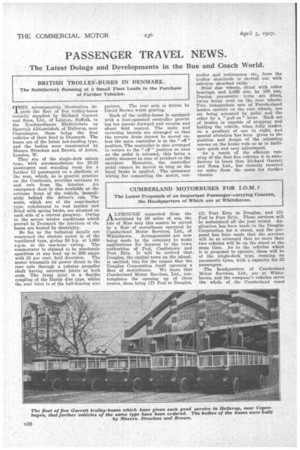PASSENGER TRAVEL NEWS.
Page 54

If you've noticed an error in this article please click here to report it so we can fix it.
The Latest Doings and Developments in the Bus and Coach World.
BRITISH TROLLEY-BUSES IN DENMARK..
The Satisfactory Running of a Small Fleet Leads to the Purchase of Further Vehicles.
TH'.accompanying illustration dePicts the fleet of five trolley-buses recently supplied by Richard Garrett and Sons, Ltd., of Leiston, Suffolk, to the Nordsjaellands Elektricitets og, Sporvejs Aktieselskab, of Hellerup, near Copenhagen, these being the first 'vehicles of their kind in Denmark. The buses are of the latest low-loading type, and the bodies were constructed by Messrs. Strachan and Brown, of Acton, London, W.
They are of the single-deck saloon type, with accommodation for. 20-21 passengers and standing room for a further 12 passengers on a platform at the rear, which, as is general practice on the Continent, provides entrance to and exit from the interior. An emergency door is also available at the extreme front of the vehicle, immediately behind the driver's cab. The seats, which are of the semi-bucket type, upholstered in real leather and fitted with spring backs, are situated on each side of a central gangway. Owing to the severe winter conditions which prevail in Denmark the interiors of the buses are heated by electricity.
So far as the technical details are concerned the electric motor is of the ventilated type, giving 50 h.p. at 1,060 r.p.m. at the one-hour rating. The commutator is claimed to be absolutely sparkless at any load up to 250 amps. with 33 per cent, field diversion. The motor transmits its power direct to the rear axle through a tubular propeller shaft having universal joints at both ends. The front joint is a flexible coupling of the Hardy disc type, whilst the rear joint is of the ball-bearing star pattern. The rear axle is driven by David Brown worm gearing.
Each of the trolley-buses is equipped with a foot-operated controller providing ten speeds forward and reverse and shunt field control. The main and reversing barrels are arranged so that the reverse drum cannot be moved unless the main controller is in the " off" position. The controller is also arranged to return to the " off " position so soon as the pedal is released, this being a safety measure in case of accident to the operator. Moreover, the controller pedal cannot be moved so long as the hand brake is applied. The necessary wiring for connecting the motor, eon troller and resistances, etc., from the trolley standards is carried out with cab-tyre sheathed cable.
Steel disc wheels, fitted with roller bearings, and 1,085 mm. by 185 mm. Dunlop pneumatic tyres are fitted, twins being used on the rear wheels. Two independent sets of Ferodo-faced brakes operate on the rear wheels, one set being actuated by pedal and the other by a "pull on" lever. Each set of brakes is capable of stopping and holding the vehicle, when fully loaded, on a .gradient of one in eight, and special attention has been given to the position and design of the adjusting screws on the brake rods so as to facilitate quick and easy adjustment.
As a result of the efficient running of the first five vehicles it is satisfactory to learn that Richard Garrett and Sons, Ltd., has recently received an order from the users for further chassis.






































































































